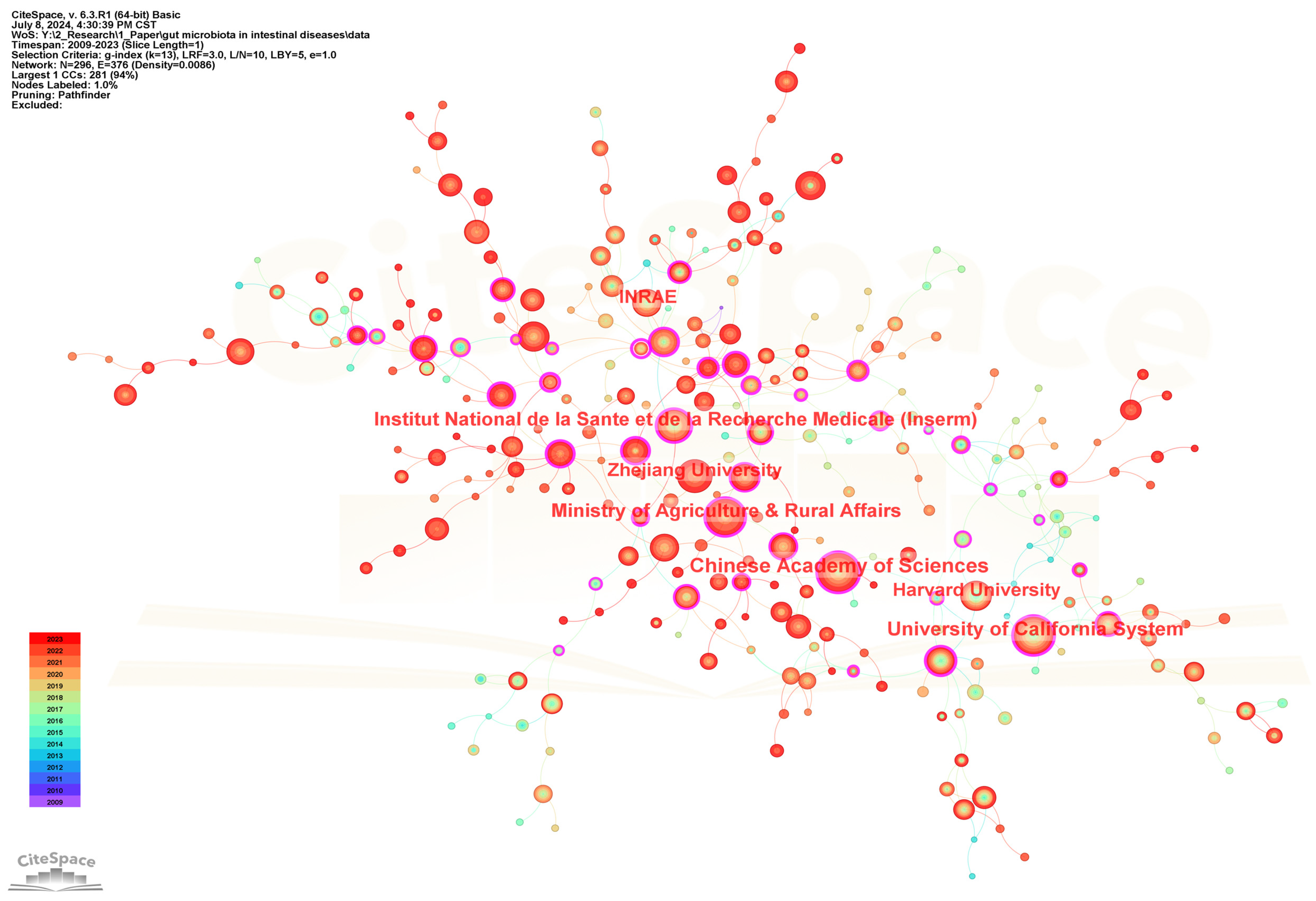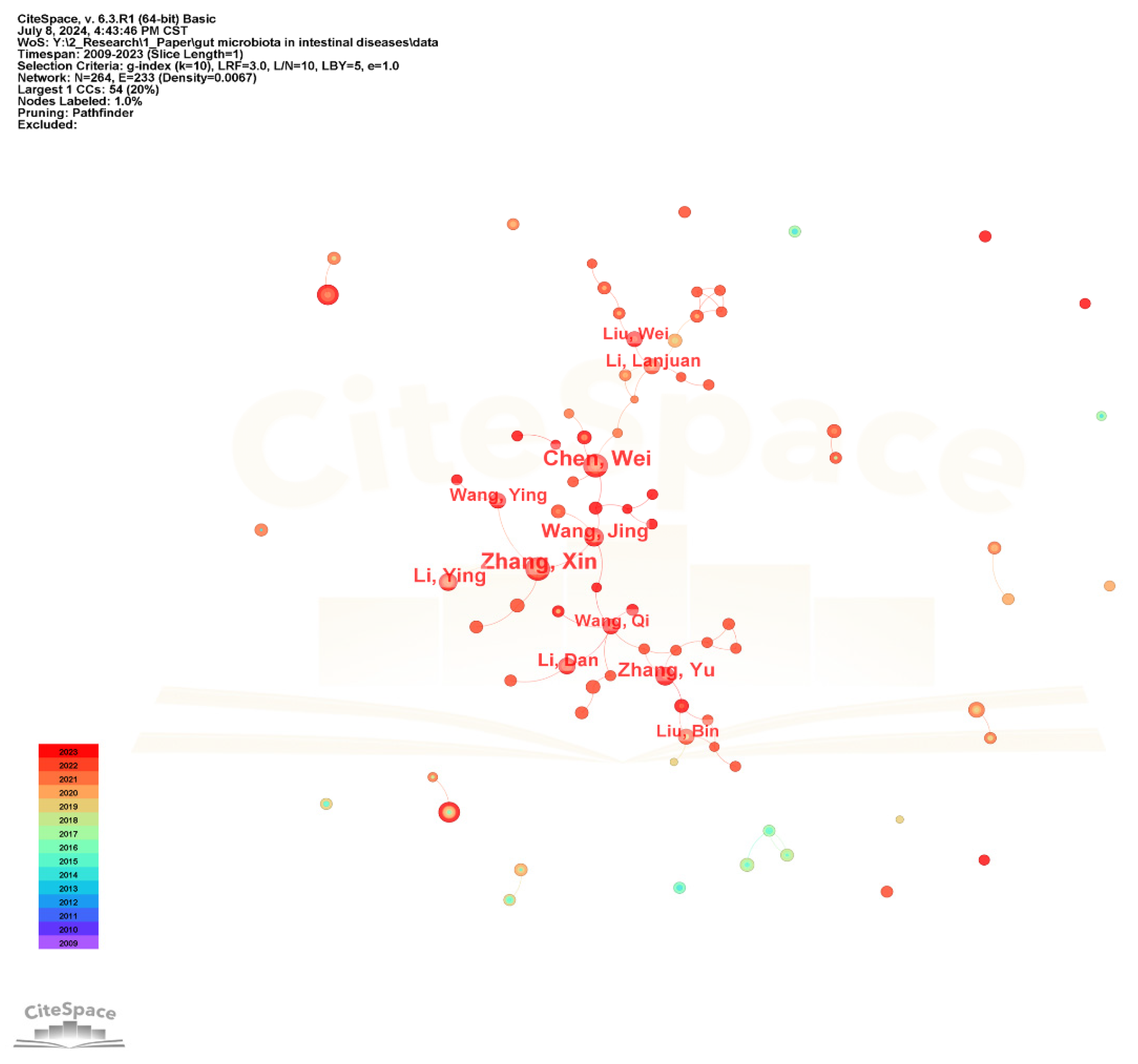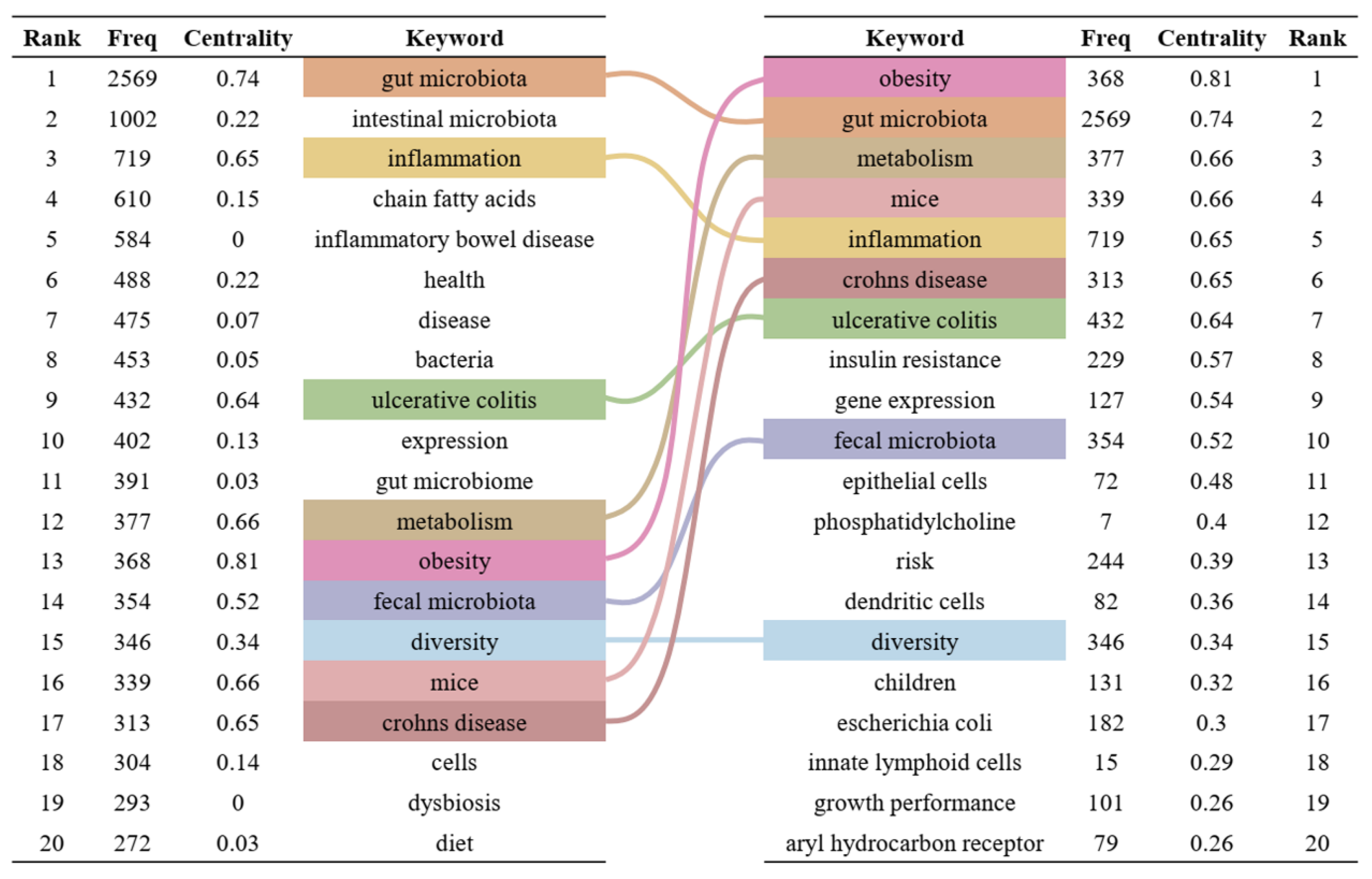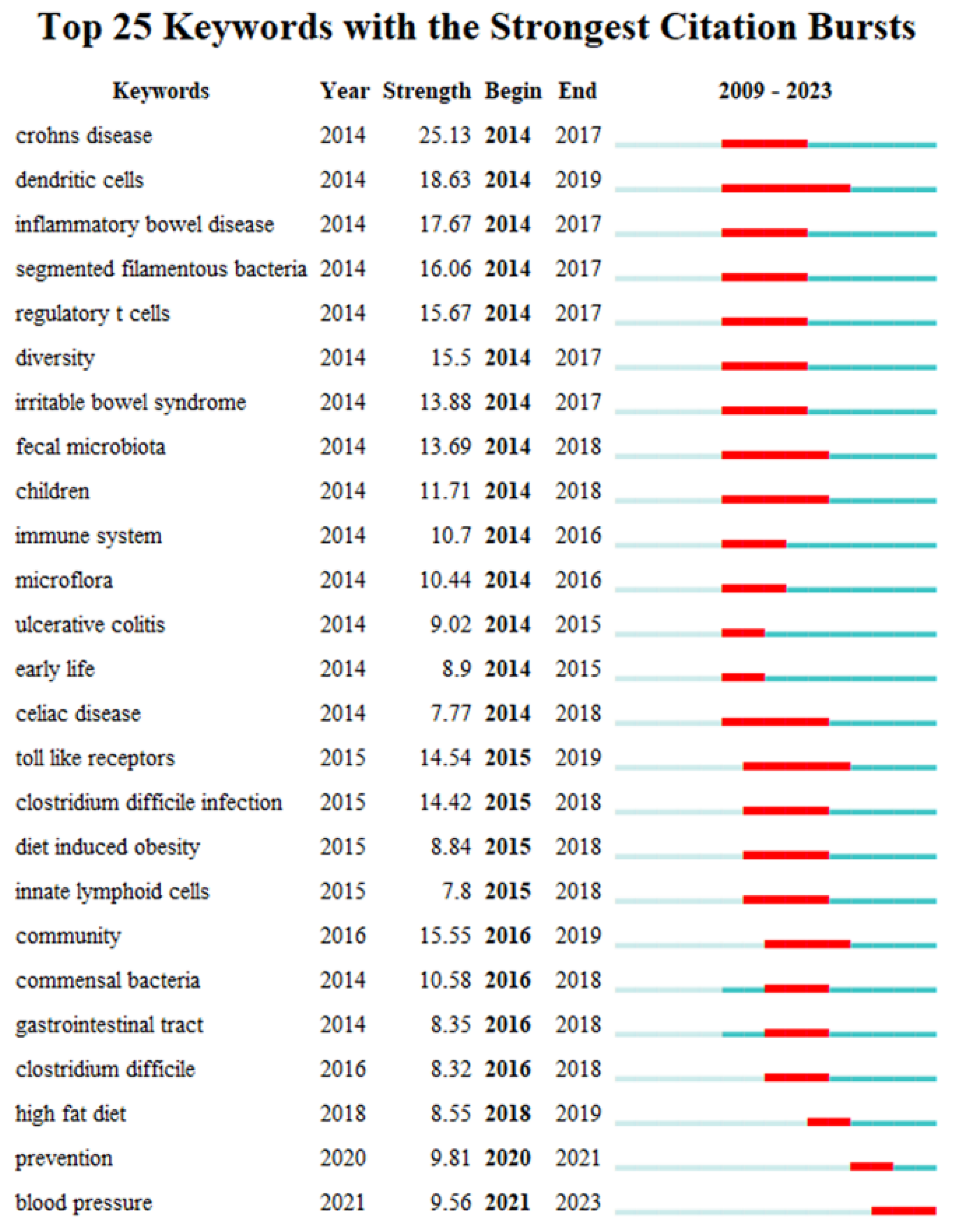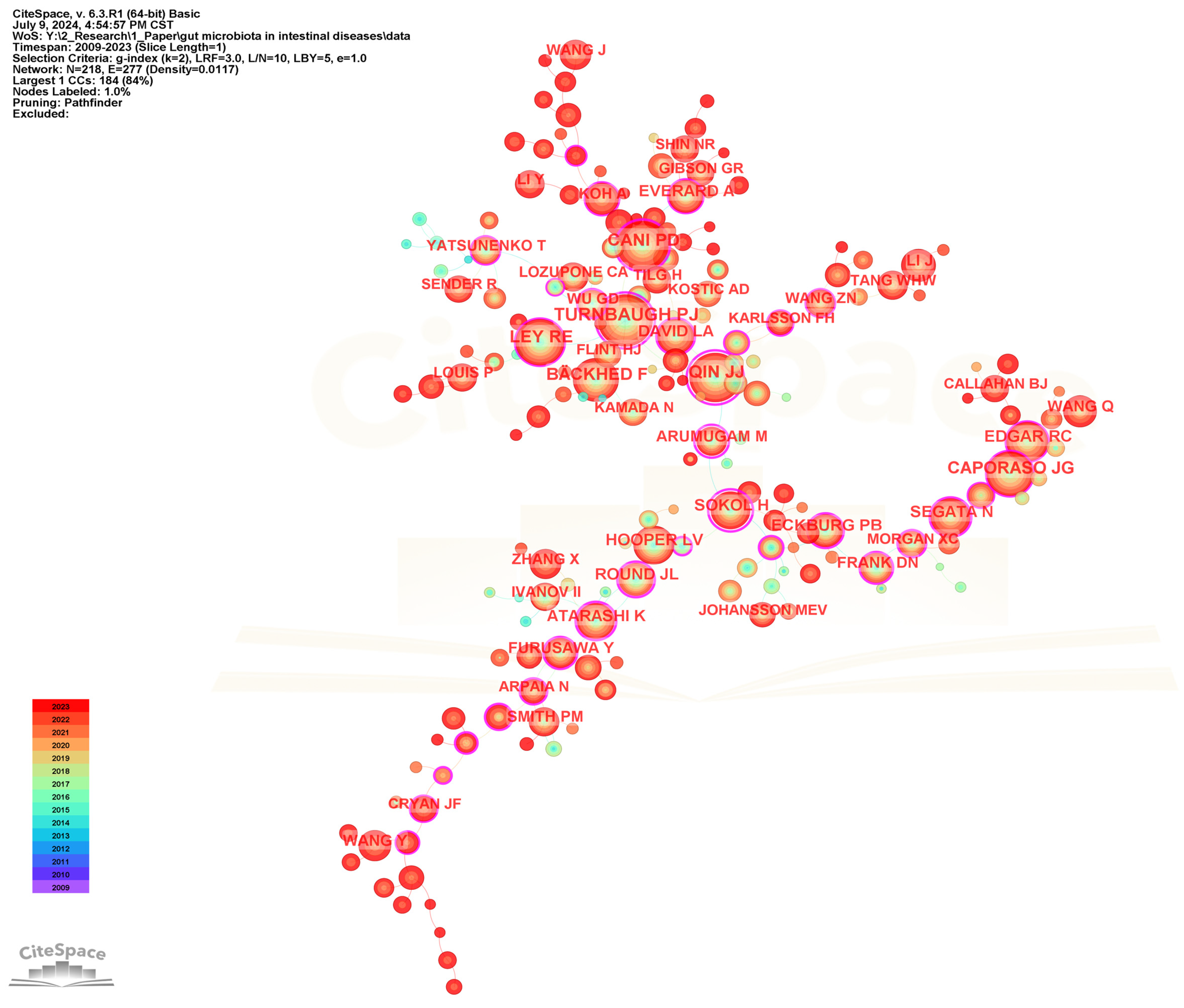1. Introduction
Trillions of symbiotic microorganisms colonize the mammalian gut and interact with the host in physiological processes, such as cell proliferation and immune response, even co-evolving with the host over thousands of years [
1,
2]. The diversity, stability, and resilience of gut microbiota, as well as their symbiotic interactions with hosts, have been formed during long-term co-evolution, which determines the complex interaction between gut microbiota and gut health [
3,
4]. Gut microbiota plays various functions in the host, including intestinal development, homeostasis, and protection against pathogenic bacteria. Gut microbiota can provide a wide range of metabolic functions for the host, which comes from anaerobic fermentation of exogenous undigested dietary components such as short-chain fatty acids (SCFAs), or endogenous substances produced by microorganisms and the host such as bile acid (BA) metabolites [
5,
6,
7]. Gut microbiota is a key regulatory factor in intestinal digestion. Gut microbiota also prevents the invasion and colonization of pathogenic bacteria by maintaining the integrity of the intestinal epithelium, as well as competing processes such as nutrient metabolism, pH regulation, and antimicrobial peptide secretion [
8]. In addition, symbiotic gut microbiota and their products can play a crucial role in regulating the development, homeostasis, and function of innate and adaptive immune cells [
9].
Growing investigations have revealed that gut microbiota is a key mediator in maintaining the health of the host’s gut, playing a complex and indispensable role in the host’s physiological and pathological state [
10]. Dysbiosis of gut microbiota is associated with the pathogenesis of various intestinal diseases (referring to diseases that affect the structure of the small and large intestines), such as irritable bowel syndrome (IBS), inflammatory bowel diseases (IBD), celiac disease (CD), colorectal cancer (CRC), and antibiotic-associated diarrhea (AAD) [
11]. IBS is one of the most common gastrointestinal diseases, and the role of gut microbiota has been extensively studied [
12]. IBD aggregates idiopathic, chronic, and relapsing inflammatory conditions of the gastrointestinal tract including ulcerative colitis (UC), Crohn’s disease (CRD), and indeterminate colitis (IC), which can be distinguished by the location of gastrointestinal inflammation [
13,
14]. Abundant evidence suggests that gut microbiota may be involved in the pathogenesis of IBD, such as the interaction between the melanocortin system and gut microbiota [
15,
16,
17]. CD is a chronic intestinal inflammatory disease caused by an abnormal immune response to the dietary gluten protein in genetically susceptible individuals. Variations in the gut microbiota may play an important role in the pathogenesis of CD [
18,
19]. As the third most common cause of cancer mortality in the world, it has been confirmed that there are significant differences in gut microbiota between CRC patients and healthy volunteers [
20,
21]. The variations in the gut microbiota, such as a decrease in butyrate producers and an increase in opportunistic pathogens, constitute the main imbalance in the gut microbiota structure of CRC patients [
21]. AAD is also one of the common intestinal diseases, which is a common adverse reaction of antibiotic treatment caused by the destruction of gut microbiota. One of its reasons is that Clostridioides difficile (formerly Clostridium) has reduced resistance to antibiotics, leading to colorectal infections [
22]. Overall, the relationship between gut microbiota and various intestinal diseases is inseparable and complex, and their interactions are still widely, deeply, and precisely studied.
At present, the research on gut microbiota and intestinal diseases has attracted more and more attention from researchers around the world, and specific research has been carried out, resulting in many research achievements [
23,
24,
25,
26]. However, there is a lack of comprehensive and systematic analysis. Therefore, we use bibliometric methods to gain a more intuitive, comprehensive, and systematic understanding of the development history, research hotspots, and future trends in the field of gut microbiota and intestinal diseases. Bibliometrics uses mathematical and statistical methods to quantitatively analyze the distribution, structure, quantity, and evolution of publication information, which is of great value in understanding the status, trends, researchers, institutions, countries, and determining future research hotspots and academic frontiers in the research field. Bibliometrics has been widely applied in the fields of gut microbiota and its association with Alzheimer’s disease, lung diseases, epigenetics, and many others, providing decision support for the advancement of scientific research [
27,
28,
29,
30]. As a commonly used analytical tool in bibliometrics, CiteSpace software is a citation visualization literature analysis tool based on scientific metrology and data visualization theory, which can effectively display the status and trends of a certain discipline or knowledge field in a specific period [
31,
32]. We used CiteSpace software to conduct a systematic and scientific analysis of publications related to the field of gut microbiota and intestinal diseases, focusing on the number of publications, countries, institutions, authors, journals, keywords, co-cited authors, co-cited journals, and co-cited references. This study aims to comprehensively and systematically understand the relationship between gut microbiota and intestinal diseases, reveal research hotspots and development trends, and provide a solid foundation and reliable reference for scholars in this field.
4. Discussion
In this study, we retrieved 5767 publications related to gut microbiota and intestinal diseases through the Web of Science Core Collection database. Various bibliometric tools, including CiteSpace and Scimago Graphica, were employed to comprehensively analyze critical indicators such as countries/regions, institutions, journals, authors, keywords, cited authors, cited journals, and cited references in the research field. The number of publications has been steadily increasing every year and shows a general upward trend. Especially after 2018, it has grown at a rate of about 200 publications per year, with the annual publication count exceeding 1000 in both 2022 and 2023. These results indicate an increasing level of interest and contributions from scholars in this specific field. Undoubtedly, the development and application of new technologies such as high-throughput sequencing and metagenomics play an important role in promoting the rise in this field [
58,
59]. Some countries or organizations have successively implemented projects related to gut microbiota and made breakthrough progress, which has also provided guidance and laid the foundation for further revealing the relationship between gut microbiota and intestinal diseases. For example, the National Institutes of Health of the USA released the Human Microbiome Project (HMP) in 2007, and the European Commission announced the launch of the Human Gut Metagenome Project in 2008.
China is the main contributor in the field of gut microbiota and intestinal diseases, followed by the USA, with a much higher number of publications than other countries. We found that 12 out of the top 20 institutions with the highest publication frequency belong to China, and 3 out of the top 5 institutions with the highest centrality belong to China. This further highlights China’s dominant position in the field of gut microbiota and intestinal diseases, indicating that China’s attention and importance to this field are increasing. It is worth noting that the Chinese Academy of Sciences is the institution with the largest number of publications, ranking fifth in terms of centrality, which means that the Chinese Academy of Sciences has the highest contribution and plays a leading role in this field.
From the perspective of journals published in the field of gut microbiota and intestinal diseases, researchers mainly focus on Frontiers in Microbiology, Nutrients, Frontiers in Immunology, Frontiers in Cellular and Infection Microbiology, International Journal of Molecular Sciences, Gut Microbes, Scientific Reports, Plos One, Food & Function, Microorganisms, and other journals. The top 20 journals belong to Q1 and Q2 of the Journal Citation Reports (16 in Q1) and 9 journals in the TOP journals, with an average impact factor of 6.4. From the perspective of cited journals, Plos One, Nature, Gut, Proceedings of The National Academy of Sciences of The United States of America, Science, Scientific Reports, Gastroenterology, Cell, Frontiers in Microbiology, and Cell Host & Microbe are the top 10 most cited journals. This series of results indicate that most publications in this field choose to be published in high-impact and high-quality research journals, indirectly reflecting the recognized importance and high research level of this field. It is worth noting that Frontiers in Microbiology, Nutrients, Frontiers in Immunology, Gut Microbes, Scientific Reports, Plos One, Gastroenterology, World Journal of Gastroenterology, and Microbiome are not only the top 20 journals with the most publications, but also the top 20 most cited journals, implying the importance of these 9 journals in the field of gut microbiota and intestinal diseases. In addition, Chinese scholars led by Zhang Xin have formed a prolific group of authors in this field. Turnbaugh PJ is the most frequently cited author.
Among the top 20 cited references, 6 are studies on the composition of gut microbiota in human health or diseases. The current epidemiological, pathological, omics, cellular, and animal research results reveal that gut microbiota to a considerable extent mediates human metabolic health and disease risk, and disrupted gut microbiota can lead to the occurrence of various intestinal diseases [
60]. The seven cited references study how to regulate gut microbiota metabolites to affect host gut health. In recent years, the metabolites and functional mechanisms derived from gut microbiota have gradually been revealed. Relevant metabolites serve as signaling molecules and substrates for metabolic reactions in the body, affecting host physiology, pathology, and other processes. At present, there are numerous types of metabolites derived from gut microbiota, which can be roughly divided into three categories based on their sources and synthesis: (1) metabolites produced by gut microbiota from dietary components, such as short-chain fatty acids, tryptophan metabolites, trimethylamine oxides, and carbohydrates; (2) metabolites produced by the host and modified by gut microbiota, such as secondary bile acids; (3) metabolites that can be re-synthesized by gut microbiota, such as bacterial vitamins, polyamines, branched-chain amino acids, lipids, and neurotransmitters [
61]. The two cited references study on the role of gut microbiota in the gut–brain axis. Gut microbiota is considered a key participant in the communication between the gut–brain axis. An increasing amount of evidence reveals bidirectional communication between the gut microbiome and the central nervous system, known as the “microbiota-gut–brain axis” [
62]. Gut microbiota can regulate the immune system, vagus nerve, enteric nervous system, neuroendocrine system, and circulatory system by producing neuroactive substances, metabolites, and hormones. Furthermore, it participates in the complex regulation of social behavior, depressive like behavior, physical performance, and motivation, among other human health and diseases [
63,
64]. There is one cited reference on the application of Quantitative Insights Into Microbial Ecology 2 (QIIME 2) tool in gut microbiome data. QIIME is the most widely used analytical process in the field of microbiome and has been named one of the 25 milestone events in human microbiome research in the past 70 years by
Nature in 2019. To meet the increasingly large scale of data and the demand for repeatable and traceable analysis, Professor Gregory Caporaso from Northern Arizona University led the development of a new QIIME 2 analysis platform from scratch, in collaboration with 112 peers from 79 institutions around the world [
36]. It is a powerful, scalable, and decentralized new microbiome analysis platform that has been recognized as the analytical standard in the field of microbiome.
Keyword analysis can reflect the research hotspots and frontiers in the field of gut microbiota and intestinal diseases [
65]. We conducted a systematic analysis of keyword co-occurrence network, clustering, and bursts. Gut microbiota, inflammation, ulcerative colitis, metabolism, obesity, fecal microbiota, diversity, mice, and Crohn’s disease are among the top 20 keywords with the highest frequency and centrality, representing the research hotspots in this field. Among the 15 keyword clusters, 9 clusters are related to the relationship between gut microbiota and host intestinal diseases, and have lasted for a long time, reflecting scholars’ continuous attention and research on the interaction mechanism between gut microbiota and intestinal diseases, such as dendritic cells, short chain fatty acids, intestinal barrier, gut–brain axis, and symbiotic bacteria. In addition, the keyword bursts analysis indicates that the field has gradually shifted its focus from the relationship between single intestinal diseases and the diversity of gut microbiota, to the role of specific and symbiotic gut microbiota in intestinal diseases, and then to the application of gut microbiota in the treatment and prevention of gut health such as high-fat diet. In other words, to gain a mechanistic understanding of the impact of gut microbiota on host gut diseases, researchers have shifted their focus from traditional descriptive analysis of gut microbiota composition to exploring causal relationships [
56]. Therefore, we believe that there are the following research trends in the field of gut microbiota and intestinal diseases: (1) The correlation between specific intestinal diseases and gut microbiota diversity, such as irritable bowel syndrome, inflammatory bowel disease, celiac disease, and colorectal cancer. (2) The mechanism of involvement of gut microbiota in intestinal diseases, such as short-chain fatty acids, intestinal barrier, and gut–brain axis. (3) Exploration of important gut microbiota related to intestinal diseases, such as probiotics, harmful bacteria, and opportunistic pathogens. (4) The relationship between gut microbiota and human intestinal health, such as obesity, diabetes, hypertension, and cancer.



